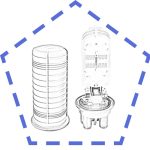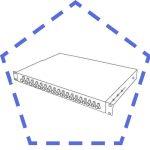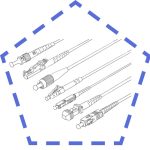FTTH enables the installation of fiber directly from the central point to the end user’s home, providing unprecedented high-speed Internet access. There are two types of technologies for implementing FTTH networks: AON (active optical network) and PON (passive optical network).
What is AON?
AON is an Active Optical Network, which mainly uses a point-to-point (PTP) network architecture, and each user can have a dedicated optical fiber line. Active optical network means that during the transmission of signals, switching equipment such as routers and switching aggregators, active optical devices, etc. are deployed from the central office to the user distribution unit. These switching equipment are driven by electricity to manage Signal distribution and direction signals for specific customers. Active optical devices include light sources (lasers), optical receivers, optical transceiver modules, optical amplifiers (fiber amplifiers and semiconductor optical amplifiers), etc.
What is PON?
PON is Passive Optical Network, a point-to-multipoint network structure, and is the main technology to realize FTTB / FTTH (fiber to the home. Passive optical network refers to ODN (optical distribution network) using only optical fibers and passive components and only needs to use active equipment at the signal source and signal receiving end.
In a typical PON system, the optical splitter is the core, and the optical splitter is used to separate and collect optical signals transmitted through the network. These splitters for PON are bidirectional. In the downstream direction, multiple services such as IP data, voice, and video are distributed by the OLT located in the central office through broadcast, and are distributed through the 1: N passive optical distributor in the ODN To all ONU units on the PON; in the upstream direction, various service information from each ONU is coupled to the same fiber through the 1: N passive optical combiner in the ODN without interference, and finally sent to the OLT at the central office for reception end.
A passive optical network includes an optical line terminal (OLT) installed at the central control office and a set of supporting optical network units (ONUs) installed at the user end. The optical distribution network (ODN) between the OLT and the ONU contains optical fibers and passive splitters or couplers. PON is divided into three technical standards: APON (ATM PON) based on ATM, EPON (Ethernet PON) based on Ethernet, and GPON (Gigabit PON) based on General Frame Protocol.
The difference
In the AON network, users have dedicated optical fiber lines, which are easy for network maintenance, capacity expansion, and network upgrades. And AON network covers a wide range, covering a range of about 100 kilometres; PON networks are usually limited to fiber optic cables up to 20 kilometres. AON mainly guides optical signals through active equipment, and PON uses passive devices without power supply, resulting in AON network deployment higher than PON cost.

 Fiber Optic Termination Boxes
Fiber Optic Termination Boxes Fiber Optic Splice Enclosures
Fiber Optic Splice Enclosures Fiber Patch Panels
Fiber Patch Panels Fiber Optic Splitters
Fiber Optic Splitters Fiber Optic Pigtails
Fiber Optic Pigtails OTDR Launch Cables
OTDR Launch Cables Fiber Optic Adapters
Fiber Optic Adapters Fiber Optic Patch Cords
Fiber Optic Patch Cords